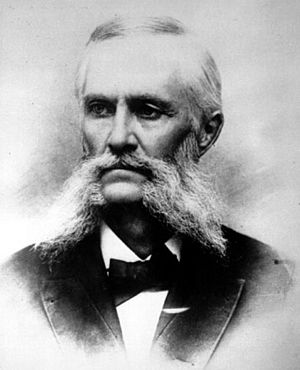A. B. Rogers facts for kids
Albert Bowman Rogers (born May 28, 1829 – died May 4, 1889) was an American surveyor. He is best known for discovering the Rogers Pass in British Columbia, Canada. Another place, Rogers Pass in the U.S. state of Montana, is also named after him. He described that pass in 1887.
Early Life
Albert Rogers was born in Orleans, Massachusetts, in 1829. He studied at Brown University for a year. Then, he transferred to Yale University, where he earned a degree in Engineering. Rogers also served in the U.S. Cavalry. He became a major during the 1862 uprising involving the Dakota Sioux.
Finding the Railway Path
Rogers first gained experience surveying land in the American prairies. He worked for the Chicago, Milwaukee, St. Paul and Pacific Railroad. In April 1881, James J. Hill of the Canadian Pacific Railway hired Rogers. His main task was to find a railway route through the Selkirk Mountains and Rocky Mountains.
Rogers carefully reviewed earlier surveyor reports. He paid close attention to those from Walter Moberly in 1865. Moberly's assistant, Albert Perry, had described a possible way to a pass. This approach was from the Columbia River along the Illecillewaet River.
On May 28, 1881, his birthday, Rogers reached a pass. This pass was at the start of the Illecillewaet River. His group was running out of food, so they had to turn back west. They had found a pass, but they still needed to explore its eastern side. This was about 18 miles (29 km) from where the Beaver and Columbia Rivers meet.
Rogers returned in 1882 to finish the job. He approached the pass from the east, following the Beaver River. On July 24, 1882, he reached the same pass. This confirmed that it was a good route for a railway.
The Canadian Pacific Railway was very grateful. They named the pass "Rogers Pass" after him. They also gave him a cheque for $5,000. Rogers did not want to cash the cheque at first. He preferred to display it in a frame. He only agreed to cash it when Van Horne promised him a gold watch as a souvenir.
Rogers was a very strict leader. Many of his workers did not like him. They often had very little food. Rogers pushed them hard to keep working. One group avoided starving only by quickly canoeing downstream.
Later Discoveries
In 1887, Rogers was surveying again for James J. Hill. This time, he was working for the Great Northern Railway. He was looking for a pass over the continental divide. He found Rogers Pass in Montana.
The Great Northern Railway later chose Marias Pass for their main railway route. This pass was 100 miles (160 km) north of Rogers Pass. However, the Great Northern still named Rogers Pass in Montana after him. Today, Rogers Pass in Montana is part of Montana Highway 200. This highway connects Great Falls and Missoula, Montana.
Rogers' surveying career ended after a bad accident. He fell from his horse while surveying near Coeur d'Alene, Idaho. He died on May 4, 1889, in Waterville, Minnesota. He had been living there with his brother. Some reports say he died from his injuries. Others say he had cancer.


